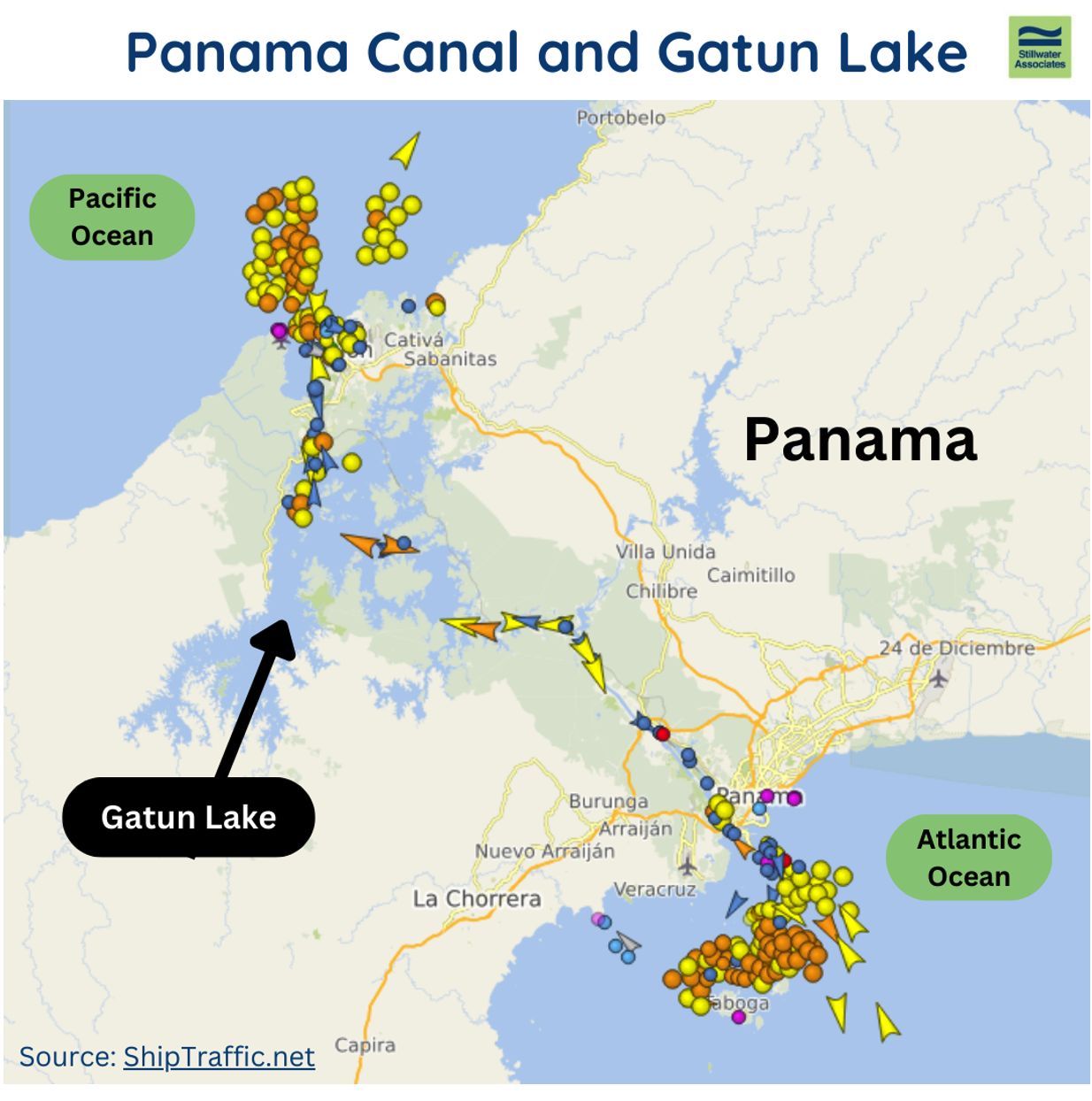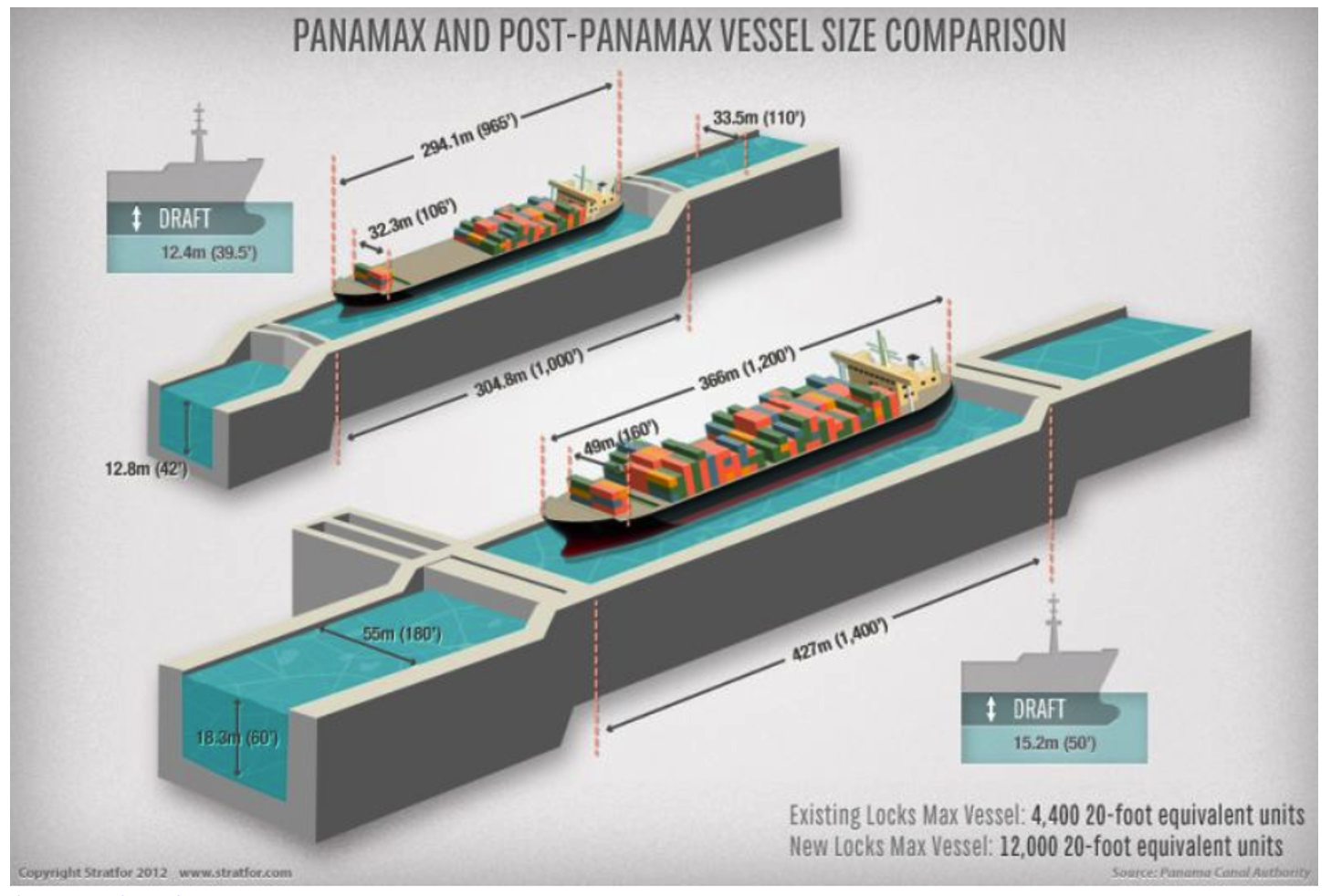What’s up with all the news on Panama Canal delays and Gatun Lake levels?
Link to article: https://stillwaterassociates.com/whats-up-with-all-the-news-on-panama-canal-delays-and-gatun-lake-levels/
August 29, 2023
Several news outlets published articles in July and August highlighting concerns about recent transit time trends through the Panama Canal. The Stillwater team had an internal conversation via Slack about potential impacts on West Coast fuels, which we thought might be of interest to our readers. We share that conversation below. First, though, a quick geographic orientation around Gatun Lake as part of the Panama Canal, with current ship traffic displayed. Bottom line: All ships transiting the Canal go through Gatun Lake.

Now, without further ado, here is a glimpse into Stillwater’s #general Slack channel on August 11, 2023:
Barry Schaps: Panama Canal delays are apparently getting out of hand. According to OilPrice.com, “As drought conditions continue to disrupt navigation along the Panama Canal, waiting times at the crucial passageway have increased to 21 days currently, prompting owners of product tankers to avoid the canal altogether and stick to intra-Atlantic voyages.”
Dave Hackett: Leigh has been watching vessel traffic between USGC & USWC. Recently he saw a vessel load at New Orleans and Mobile and then discharge at T2 (Marathon) in Long Beach. The Lynn M. Rose (an articulated tug barge) spent 34 hours at the Panama Canal. I transited the canal four years ago on a cruise ship. It took about eight hours, no waiting. Quite the engineering marvel!
Jim Mladenik: This is a potential boon to West Coast refiners looking to export diesel into the West Coast of Latin America. The need for WC diesel exports increases dramatically as over 100 KBD of additional RD finds its way to the WC in the next year or so…
Is this expected to be a short- or long-term phenomenon?
Dave Hackett: This has been going on for some time. Some years are wetter than others. They have made operating changes to preserve the freshwater that is fed from Gatun Lake to the locks on either side. (Editor’s note: Each transiting ship requires about 50 million gallons of water from Gatun Lake to operate the locks.)
Barry Schaps: The product carriers are Panamax vessels. They cannot afford to take the long way around, so they will sit and wait. The answer to Jim’s question lies with the weather pattern of El Nino or La Nina, which do not appear to be changing any time soon. (Editor’s Note: For example, droughts caused by El Nino in 2015 led to restrictions on ship draft.)
Adam Schubert: Gatun Lake requires enough water to operate the locks while keeping lake levels sufficiently deep that vessels can transit. All depends on there being sufficient rainfall in the adjoining rainforest. (Editor’s Note: A comprehensive meteorological and hydrological dashboard helps the Canal Authority manage the balance.)
Nick Griffith: The Gatun water level just keeps on falling reducing maximum permitted transit draft, and the canal and vessel operators constantly calculate how to adjust pricing and transit priority to satisfy themselves and vast numbers of parties seeking transit. Some vessels just sail short cargo, loading less to reduce draft. Others, like Royal Caribbean Cruises, cancel all Canal passages, probably because of the cost. (Editor’s Note: The graphic below shows the difference between the Panamax and post-Panamax draft requirements, of ~39.5 feet and ~50 feet, respectively. On August 28th, the Panama Canal Authority limited max draft of post-Panamax vessels to 44 feet.)
 Source: Stratfor.com
Source: Stratfor.com
 Source: Panama Canal AuthorityGatun Lake Water Level Dashboard
Source: Panama Canal AuthorityGatun Lake Water Level Dashboard
I guess what we need besides rain down there are more wide and long wet bulk barges and ships to take full advantage of the expanded post Panamax lock dimensions. Easy to say, expensive and time consuming to build but considering how useful such wider, longer hulls would also be in shallow rivers like the Mississippi (which also often suffers the same drought-induced draft restrictions beyond the normal seasonal draft reduction), maybe some company will be motivated to build some. They would be a sweet ride.
Leigh Noda: I had been rabbit holing vessels in trying to see if there was a way to track WC movements and especially RD movements from the USGC. I developed a crude manual tracking system in late July. With enough data on historic vessel calls and the vessels that visit ports of interest I’ve been able to develop a list of the RD vessels over a bit of time. It’s not perfect and does have an imperfect match with SLC (California State Lands Commission) data. The data suggests that the canal transit hasn’t been a major bottleneck to these tankers. Perhaps part of it is that those tankers can use the old as well as the new canals.
This is just a peek into the kind of conversations and analysis that are happening at Stillwater all the time. We’ll be tracking the arbitrage opportunities created by the situation in the Panama Canal. Be sure to contact us if you have any questions!
